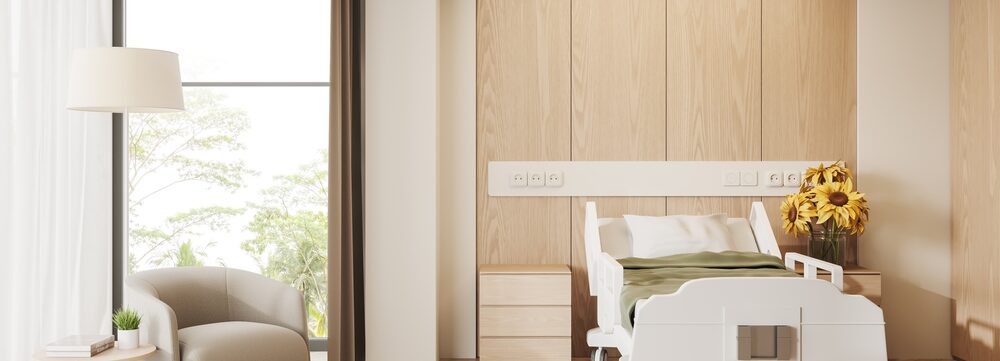Blog
Embracing Technology in Healthcare Design to Revolutionize Germ Control and Create Safer Environments

The mission of healthcare designers is to create optimal spaces where patients can heal and staff can provide high-quality care. One of the greatest challenges we face in healthcare facilities is maintaining a clean and germ-free environment. In recent years, technology has emerged as a valuable ally in the battle against harmful microorganisms. With the help of innovative solutions, we can effectively curb the spread of germs, enhancing the safety and well-being of both patients and medical personnel.
Installing Smart Hand Hygiene Systems
The importance of proper hand hygiene in healthcare cannot be overstated. Historically, manual monitoring of hand hygiene compliance has been time-consuming and prone to errors. However, technology has introduced smart hand hygiene systems that provide a convenient and efficient solution. Battery-operated sensors can be placed strategically in and around each patient room to match the facility’s hand hygiene compliance standard. Next, staff utilize wearable devices, such as electronic badges or bracelets, which monitor the frequency and duration of handwashing or the use of hand sanitizers. By using built-in sensors, these devices can also ensure that healthcare workers are following recommended techniques for optimal efficacy. These smart-systems track compliance rates and provide real-time feedback, allowing facility managers to identify areas for improvement and tailor training programs accordingly. See an example.
Automated Disinfection Robots
Healthcare Designers can make room for automated disinfection robots. Traditional manual cleaning processes, although important, may be insufficient in eliminating harmful pathogens in high-risk areas such as operating theaters or isolation rooms. Automated disinfection robots are now transforming the way healthcare facilities manage their efforts to control germs. These robots utilize ultraviolet-C (UVC) light technology or hydrogen peroxide vapor to kill bacteria, viruses, and other microorganisms efficiently. The advantage of these robots lies in their ability to reach commonly missed or hard-to-access areas. By reducing human error, these advanced machines not only enhance overall cleanliness but also help minimize the risk of healthcare-associated infections (HAIs). See an example.
Touchless Systems and Voice-Activated Interfaces
Designing spaces with minimal touchpoints can significantly reduce the transmission of germs. Integration of touchless systems and voice-activated interfaces in healthcare facilities has become increasingly popular. From touchless faucets, soap dispensers, and waste disposal units to voice-activated controls for lighting, temperature, or entertainment systems in patient rooms, these technologies minimize contact and thereby mitigate the risk of cross-contamination. Additionally, voice-activated interfaces allow patients and staff to interact with devices and access information without physically touching them, promoting a safer and more hygienic environment. Optimizing Efficiency in Healthcare Design with Occupancy Sensors
Remote Monitoring and Telehealth Pods
Healthcare Designers can take advantage of remote monitoring and design onsite or offsite telehealth pods. Technological advancements have also revolutionized patient care and reduced the transmission of contagious diseases by minimizing the need for in-person visits. Remote monitoring devices, wearable sensors, and telehealth platforms enable healthcare providers to monitor patients’ vital signs, track health trends, and provide consultations from a distance. Patients can receive medical advice, access prescriptions, and share health data with their physicians without physically visiting the facility. This not only reduces potential germ exposure but also improves patients’ overall experience by eliminating the need to travel or wait in crowded waiting rooms. See an example.
Embracing Technology in Healthcare Design to Revolutionize Germ Control and Create Safer Environments
Incorporating technology into healthcare design has revolutionized germ control and introduced new possibilities for patient care and staff safety. Smart hand hygiene systems, automated disinfection robots, touchless systems, and telehealth pods that use remote monitoring solutions all contribute to creating a cleaner, safer healthcare environment. By leveraging these transformative technologies, healthcare designers can play a substantial role in reducing the spread of infectious diseases, improving patient outcomes, and ultimately enhancing the overall experience for everyone within the healthcare setting. As we continue to embrace technology, we move closer to achieving the perfect balance between innovation and compassion in healthcare design.
Marie Wikoff is the creator of Wikoff Design Studio based out of Reno, Nevada. Her expertise in healthcare design has helped modernize healthcare organizations locally, regionally, and internationally, improving patient experience and outcomes. Her credentials include Evidence-Based Design Accreditation and Certification (EDAC), American Academy of Healthcare Interior Designer (CHID), the National Council of Interior Design Qualification (NCIDQ) and LEED AP. Contact Marie Wikoff







